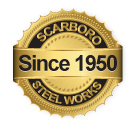Get to Know: How Steel Beams Are Fabricated
Take a look around you, you’ll most likely come to see a free-standing structure of some sort that has been built to serve a purpose for human needs. What’s the one thing these structures have in common? Steel beams.
From residential houses to commercial skyscrapers, you’ll be hard-pressed to find a structure that isn’t reliant upon these titans of industry.
What is it exactly that makes them so prevalent? At the end of the day, it comes down to their mechanical properties – high strength, anti-corrosive, durable, ductile, and light in weight.
Don’t be mistaken, though. While steel beams can provide invaluable solutions, infallible they are not. Prolonged or severe curvature can exponentially increase their failure rate and can be traced back to local instabilities or plate elements buckling. This buckling is known to take place when instability occurs at the flanges or web of a beam’s hollow sections.
The point we’re attempting to drive home is that scrupulous design and manufacturing efforts must be put into the fabrication of steel beams to prevent, as much as is possible, these issues from occurring that are known to compromise structural integrity.
Let’s mull over some of the unique ways fabricators go about fabricating the steel beams that provide society the solace they expect:
Rolled and Extruded Beams
This method of fabrication involves the use of pliable metal being flattened and molded into the necessary shape by way of large rollers. Depending on how the steel in question is processed at the mill, they can be either hot-rolled or cold-rolled; let’s look into how these differ:
- Hot-rolled steel: the steel is rolled at temperatures close to 1,000°C. The main objective here is to surpass the steel’s recrystallisation point, i.e. the point below melting, allowing for effective reformation of the steel via, in this case, rolling.
- Cold-rolled steel: similar in nature to hot-rolled steel, albeit with additional processing, consisting of the steel being cooled at room temperature, and subsequently annealed. The cold-rolling process is conducted when fabricators are looking to achieve high-quality finishes.
To touch upon the extrusion process, this can also be subcategorised into a hot or cold process. In essence, the steel work piece is pushed through a die, making it conform to the new and smaller cross-sectional area.
Welding
One of the more common protocols of fabricating steel beams is by way of welding – a metal sheet is cut to specified dimensions and then welded together.
In simple terms, welding involves the use of an electric arc that can melt material of the joint while, simultaneously, combining with a filler material that is fed to form a weld pool that solidifies and fuses the joint and filler material with one another.
A host of welding techniques are to be used, depending on the fabrication task at hand. Let’s take Metal Active Gas welding (MAG) as an example, this weld method is used for longer stretches of weld as it involves an uninterrupted wire, carrying current, that is fed through a roller wire-feeder by a power source – an effective means of melting and fusing the steel beams with the electrode wire.
There you have it, fabrication protocols such as these have been honed over decades to allow society to have confidence in the structures they utilise day in, day out.
That’s why, when you partner alongside Scarboro Steel Works, you can count on the pedigree and certifications at our disposal; the vast assortment of steel beams we supply are compliant with building codes throughout Ontario. Whether you’re looking for steel plates, angles, HSS sections, or otherwise, get in touch to see why we’re synonymous with all things steel!






